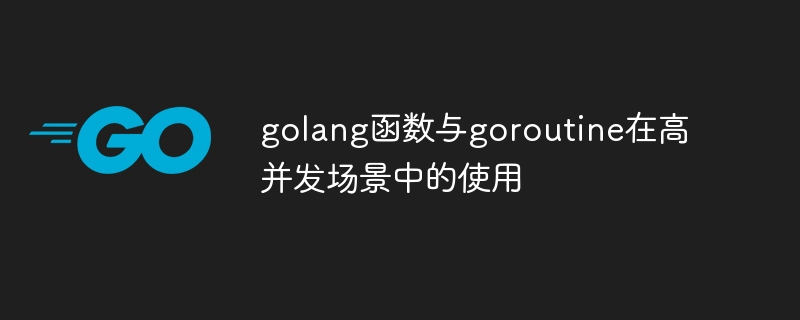
In high-concurrency scenarios, Go functions are declared through func and support synchronous and asynchronous execution. Goroutine is a lightweight thread created by go that supports executing tasks simultaneously. In the example, multiple Goroutines execute time-consuming task functions in parallel, improving program concurrency. Goroutines have low overhead and perform better than threads, and concurrency can be expanded as needed.

The use of functions and Goroutine in Go in high concurrency scenarios
Introduction
The concurrency features of the Go language are very useful when dealing with high-concurrency scenarios. Functions and Goroutines are two core concepts for achieving concurrency. Functions are independent units of code, and Goroutines are lightweight threads that execute these functions.
Function
A function is declared with the func keyword, followed by the function name, parameter list, and return value type. Functions can be synchronous or asynchronous. Synchronous functions are executed immediately in the current Goroutine, while asynchronous functions create a new Goroutine to execute the function.
Goroutine
Goroutine is a lightweight concurrency unit created through the go keyword. They are similar to threads but have lower overhead. Goroutines can be executed simultaneously, thereby improving program concurrency.
Use Case
Consider the following scenario: We need to process a set of tasks, each of which requires time-consuming calculations. We can use Go's functions and Goroutines to achieve parallel processing.
package main
import (
"fmt"
"time"
)
func task(id int) {
fmt.Println("Task", id, "started")
time.Sleep(time.Second)
fmt.Println("Task", id, "completed")
}
func main() {
for i := 0; i < 10; i++ {
go task(i) // 创建一个 Goroutine 来执行 task 函数
}
time.Sleep(time.Second * 2) // 给 Goroutine 足够的时间完成
}In this example, we define a task function that performs some time-consuming calculations. We create a new Goroutine with the go keyword to execute this function, passing in a unique ID to identify the task. The main function creates 10 Goroutines, each Goroutine is responsible for processing a task. By giving the Goroutines some time to complete their tasks, we can see them execute in parallel.
Advantages
Using functions and Goroutines has some advantages in high concurrency scenarios:
Conclusion
Go language functions and Goroutines are powerful tools for achieving high concurrency. By putting time-consuming tasks into Goroutines, we can improve the performance and scalability of our programs.
The above is the detailed content of The use of golang functions and goroutine in high concurrency scenarios. For more information, please follow other related articles on the PHP Chinese website!
 How to define variables in golang
How to define variables in golang
 What are the data conversion methods in golang?
What are the data conversion methods in golang?
 What are the commonly used libraries in golang?
What are the commonly used libraries in golang?
 What is the difference between golang and python
What is the difference between golang and python
 what is javaweb
what is javaweb
 WeChat Moments, two dashes and one dot
WeChat Moments, two dashes and one dot
 How to change file type in win7
How to change file type in win7
 wps replacement shortcut keys
wps replacement shortcut keys
 OKEX official website
OKEX official website




